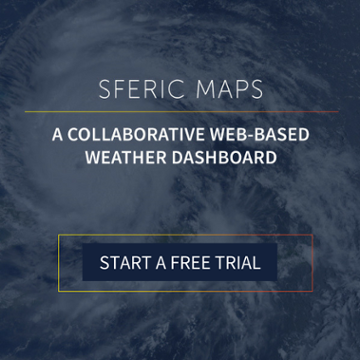Severe Weather and Wind Farms: 3 Conditions That Disrupt Operations
- Apr 05, 2018
Severe weather and wind farms are a dangerous mix. When unfavorable weather conditions approach a wind farm, the top priority is worker safety. It’s imperative that management gets workers off of the turbines and into cover before severe weather hits.
However, it’s common for inadequate weather intelligence solutions or no solutions at all to leave workers in a dangerous position. The following severe weather conditions are the most common and most dangerous to wind farms. Keep reading to find out what they are and how you can protect your wind energy operations from them this year.
Lightning

The biggest severe weather challenge to wind farm operations is lightning. No matter where you operate, lightning is a constant severe weather threat. Don’t believe us? Believe this: Lightning strikes the Earth’s surface 3 billion times per year.
While different areas see more lightning strikes than others, lightning can strike at any place at any time. The problem is that many people, including wind farm workers, wait until they see lightning or hear thunder to move into safety. This is too late. Lightning can strike from nearly 12 miles away. By the time you see lightning or hear thunder, you are already in immediate danger of being struck.
In order to minimize this severe weather risk at wind farms, organizations can implement new lightning safety procedures that rely on early warning systems based on total lightning detection. Total lightning is the combination of all cloud-to-ground lightning strikes and in-cloud lightning strikes. It’s a best practice to rely on total lightning because nearly 80% of all lightning strikes happen in the clouds. While these aren’t immediately dangerous to workers or infrastructure, they are a precursor to deadly cloud-to-ground strikes and other forms of severe weather like wind gusts, tornadoes, and hail.
Wind

The next condition that makes severe weather and wind farms a dangerous combination is the wind. This is especially true for offshore operations. Sure, wind farms need the wind – it’s right in the name! But too much wind can be dangerous for both workers and equipment.
As most wind farm management knows, turbines have systems that will automatically halt operations when wind speeds exceed 55 mph. This “survival mode” keeps the turbines standing upright because when the wind blows too fast through the turbines it can compromise the integrity of the foundation.
When organizations use weather intelligence, you can not only see real-time wind gust information but see the forecast. Even if the gusts let up for 15 minutes, it might not be financially smart to get the turbines running again for that short of a time. An accurate wind forecast at your altitude helps decision-makers extend automatic shut-offs when more wind is in the near forecast.
Hurricanes

This last severe weather event doesn’t affect every wind farm operation because of location, but hurricanes are a huge problem. Like the wind, a hurricane also has a bigger effect on offshore wind farming operations. On top of wind issues, hurricanes also bring storm surge. Storm surge is another severe weather conditions that can affect the structural integrity of wind turbines.
There isn’t much to stop these powerful forces of Mother Nature from damaging or destroying infrastructure. While engineers do design these structures with models that help them prepare, recent Hurricanes Irma and Maria still did a lot of damage to infrastructure off of the coast. The best you can do is to ensure your employees are in a safe area before the conditions start. There is also plenty of hurricane-resilient research going on, so make sure you keep an eye on that.
Protect Employees with Severe Weather Intelligence

You can mitigate the risks associated with these weather conditions as long as you know they are coming ahead of time. There are a few different ways to receive severe weather alerts. Take a look at the following methods to see which one might fit your operations best.
Horn/Strobe
The fastest way to alert employees is with a horn/strobe system that is hooked up to a weather network. That way, the alerts are immediate, unmistakable, and hard to miss. These outdoor alerting systems also let employees know when the danger has passed with an “all-clear” alert, which gets your operations up and running again as soon as conditions are safe.
Text/Email
The second alerting method we see wind farms and other organizations use is a text or email alert. These alerts, like horns, should also be hooked up to a weather or lightning network (or both). Automated alerts are the only way to go when it comes to severe weather because it ensures that you have alerts set up for your locations and the weather conditions that matter to you most. It’s easy to make customizable alerts through our Sferic Maps and Sferic Mobile interfaces. You can try a free trial today:
How Do You Protect Your Wind Farms from Severe Weather?
Are you currently mitigating severe weather risks in a successful way? Let us know how you handle Mother Nature’s most dangerous conditions in the comments below.







